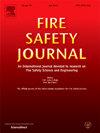Assessment of the proposed wildfire curves for housing design protection
IF 3.4
3区 工程技术
Q2 ENGINEERING, CIVIL
引用次数: 0
Abstract
The need to protect structures from the hazards of wildfires remains an area requiring further investigation. In this context, this study focuses on the analysis of a novel approach for defining and implementing standardized wildfire curves (WC) for the fire safety design of dwellings at the wildland-urban interface (WUI). The primary objective is to introduce the proposed WC and evaluate its representativeness in comparison to real cases documented in the literature, thereby validating its applicability. Emphasis is placed on the development of realistic standard fire time-temperature curves for natural fuels such as trees, shrubs, and litter. An extensive literature review was conducted to collect the most relevant time-temperature datasets, spanning experimental research from the 1960s to the most recent studies in 2023. These datasets were obtained using thermocouple devices positioned at various heights within the fuel bed. The study incorporates data from field tests, laboratory experiments, and real-life wildfire incidents in Portugal and other countries. Additionally, the authors present temperature curves acquired in situ from wildfires they monitored. Furthermore, a case study involving an external wall composed of classical construction materials commonly used in Portugal is numerically analyzed using the proposed WC. The heat transfer analysis examines the temperature distribution and internal heat flux. The results indicate that the WC effectively represents the scenario in which the highest internal temperatures within a dwelling are observed, highlighting its potential applicability in fire safety design.
评估房屋设计保护的拟议野火曲线
保护建筑物免受野火危害的必要性仍然是一个需要进一步调查的领域。在此背景下,本研究重点分析了一种定义和实施标准化野火曲线(WC)的新方法,用于荒地-城市界面(WUI)住宅的消防安全设计。主要目的是介绍建议的WC,并与文献中记录的真实案例进行比较,评估其代表性,从而验证其适用性。重点放在发展现实的标准火灾时间-温度曲线的自然燃料,如树木,灌木和凋落物。我们进行了广泛的文献综述,收集了最相关的时间-温度数据集,涵盖了从20世纪60年代到2023年最新研究的实验研究。这些数据集是通过位于燃料床内不同高度的热电偶装置获得的。该研究结合了来自葡萄牙和其他国家的实地测试、实验室实验和真实野火事件的数据。此外,作者还提供了他们监测的野火现场获得的温度曲线。此外,一个案例研究涉及到葡萄牙常用的经典建筑材料组成的外墙,使用拟议的WC进行了数值分析。传热分析考察了温度分布和内部热流密度。结果表明,WC有效地代表了观察到的住宅内部最高温度的情景,突出了其在消防安全设计中的潜在适用性。
本文章由计算机程序翻译,如有差异,请以英文原文为准。
求助全文
约1分钟内获得全文
求助全文
来源期刊

Fire Safety Journal
工程技术-材料科学:综合
CiteScore
5.70
自引率
9.70%
发文量
153
审稿时长
60 days
期刊介绍:
Fire Safety Journal is the leading publication dealing with all aspects of fire safety engineering. Its scope is purposefully wide, as it is deemed important to encourage papers from all sources within this multidisciplinary subject, thus providing a forum for its further development as a distinct engineering discipline. This is an essential step towards gaining a status equal to that enjoyed by the other engineering disciplines.
 求助内容:
求助内容: 应助结果提醒方式:
应助结果提醒方式:


